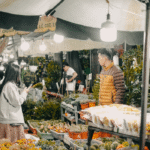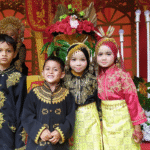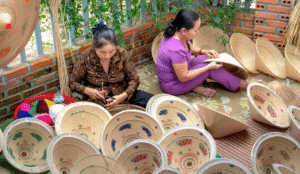Introduction
The word kampung may seem simple at first glance, but in Malaysia, it carries layers of meaning—of culture, simplicity, community, and rhythm. A kampung is not just a village; it’s a heartbeat. It’s where time slows down, where the rooster crows are still the morning alarm, and where the scent of sambal in a traditional kitchen stirs memories and stories.
While Malaysia’s cities are booming with skyscrapers, malls, and rapid development, the kampung remains a symbol of its soul—preserving customs, beliefs, and ways of life that have endured generations. Whether tucked into the rice paddies of Kedah, nestled among the hills of Negeri Sembilan, or along the serene coasts of Terengganu, each kampung offers a glimpse into a Malaysia many visitors never see.
This article takes you on an intimate journey into the daily life of a Malaysian kampong. From morning routines to community celebrations, from traditional crafts to evening gatherings, you’ll discover why the kampung life is both timeless and treasured.
Frequently Asked Questions (FAQ)
1. What is a traditional Malay kampung?
A traditional Malay kampung is a rural village in Malaysia where people live in close-knit communities, often surrounded by rice fields, coconut trees, or rivers. Houses are usually made of wood and built on stilts, and life in a kampung is simple, peaceful, and deeply rooted in tradition. It’s a place where neighbors know each other well, and customs like sharing food and celebrating festivals together are part of daily life.
2. What is life in Malaysia like?
Life in Malaysia is a blend of modern living and cultural tradition. In the cities, you’ll find skyscrapers, shopping malls, and fast-paced lifestyles. But in smaller towns and villages, life moves more slowly, with strong community ties, local markets, and cultural practices still thriving. Malaysians are known for being friendly and welcoming, and daily life often revolves around food, family, and festivals from various cultures.
3. What are Malaysian villages called?
Malaysian villages are called “kampung” (also spelled “kampong”). The word refers to rural settlements, especially those in traditional or agricultural areas. A kampung can be found in the countryside, along rivers, or even on the outskirts of towns. They’re known for their natural surroundings, traditional wooden houses, and slower pace of life.
4. What is the kampong culture?
Kampong culture refers to the traditional way of life in rural Malaysian villages. It emphasizes community spirit, mutual help, and simple living. In a kampung, people often grow their own food, cook together for celebrations, and rely on neighbors like family. The culture includes traditional games, crafts, local farming, and strong respect for elders and customs.
5. What does kampung mean in Malaysia?
In Malaysia, the word “kampung” means village or rural settlement. It represents not just a place, but also a lifestyle connected to nature, tradition, and community. When Malaysians say someone has a “kampung spirit,” they’re talking about being helpful, humble, and community-minded—values that are still cherished today.
Morning in the Kampung: A Gentle Awakening
In the kampong, the day begins not with alarms, but with the natural chorus of life. Roosters crow from the chicken coops, the distant call to prayer echoes from the surau or masjid, and early risers sweep their wooden verandas clean of fallen leaves.
Many households begin their day by lighting a small fire or gas stove for breakfast. Nasi lemak wrapped in banana leaves, roti canai with dhal, or simply kopi O and kuih-muih set the tone for a humble yet hearty start. Elders sip their coffee while chatting over fences or gathering under shady trees. Children, in pressed school uniforms, walk or cycle to school—often with a wave to familiar neighbors along the way.
Unlike the rushed chaos of urban mornings, life in the kampung allows for a slower, more intentional pace. There’s time to greet people. There’s time to watch the mist lift from the hills. There’s time to breathe.
The Heart of the Home: Wooden Houses on Stilts
Traditional homes in the kampong are architectural gems. Built on stilts, these houses allow air to circulate, protect from floods and wildlife, and often serve as cool retreats from the midday heat. The pangkin (raised platform) at the front of the house is where much of the day’s informal life unfolds—from mending fishing nets to peeling vegetables or simply sharing gossip with neighbors.
Inside, homes are simple but functional. Woven mats cover the wooden floors, family photos line the walls, and kitchens are often semi-open, allowing cooking smells to drift into the garden. Despite lacking many modern conveniences, there’s warmth, organization, and pride in every corner.
Each kampong has its own distinct house styles, often reflecting local materials—bamboo in the east, nibong palm in the south, and timber from local forests. What binds them is the sense of openness and communal living, designed for extended families and multiple generations under one roof.
Midday Activities: Farming, Crafting, and Community Work
As the sun climbs higher, the kampong bustles with productivity. In agricultural villages, families head to the sawah (rice fields), rubber plantations, or fruit orchards. Men often tap rubber, climb coconut trees, or work on boats, while women may tend to gardens, weave baskets, or prepare ingredients for the next meal.
The rhythm of work is guided by nature. In fishing villages, mornings might begin before dawn, with boats returning by midday. In farming kampungs, the work follows seasonal patterns—planting, tending, and harvesting rice, durian, jackfruit, and bananas.
Craftsmanship also flourishes. In certain kampungs, you might find artisans carving intricate keris blades, weaving songket fabrics, or producing traditional batik. These are not just hobbies—they’re heritage passed from one hand to another, often with great pride.
Importantly, daily life in a kampong is rarely isolated. Tasks are often communal. A neighbor might lend a hand building a fence; another might share a harvest of rambutans. There’s a spirit of gotong-royong, or mutual cooperation, that binds the community together.
Lunch and Rest: Family Meals and Midday Respite
Lunch is often the most substantial meal of the day. Dishes are prepared fresh, using local ingredients grown or caught just steps from the home. A typical meal might include ikan bakar (grilled fish), ulam (raw vegetables with sambal), and freshly steamed rice. Meals are enjoyed sitting cross-legged on the floor, surrounded by family.
In the hottest hours of the day, most kampong folk take time to rest. Hammocks are strung beneath the house or under trees, and children often nap or play quietly. This period of pause is not laziness—it’s respect for the sun, the body, and the cycle of the day.
Afternoon Rituals: Tea, Prayer, and Leisure
As the sun begins to dip, the kampong reawakens. Children return from school, adults finish chores, and homes prepare for evening. Many households gather for minum petang, or tea time, enjoying goreng pisang (fried bananas), cucur udang, or traditional kuih with hot tea.
It’s also a time for spiritual connection. In predominantly Muslim kampungs, the call to Asar prayer draws the faithful to the surau. Spirituality is deeply woven into kampung life—through prayers, rituals, and respect for ancestral traditions.
As the light softens, villagers may take walks, tend to animals, or visit neighbors. In some kampungs, a game of sepak takraw or badminton brings energy and laughter to an open space. Others may gather at the warung (small food stall) for a chat or a simple meal of mee goreng and iced Milo.
Evening: Togetherness Under the Stars
When night falls in the kampong, it brings a kind of quiet magic. Unlike cities bathed in artificial light, kampungs are lit by stars, kerosene lamps, or solar bulbs. Dinner is often a simple, shared affair—fish soup, stir-fried greens, and leftovers from lunch.
Post-dinner hours are social and calm. Families sit on the verandah, telling stories, playing card games, or listening to the radio. Elders share tales of pontianak (ghosts), floods, or past harvests. Children laugh in clusters, catching fireflies or telling jokes.
There’s little rush. Time in the kampong feels elastic. It stretches long enough for meaningful conversations, for reflection, and for stillness. Evenings are often concluded with a prayer, a cup of warm milk, or a stroll under the moonlight
Festivals and Celebrations
Life in a kampong is marked by vibrant communal celebrations. Hari Raya Aidilfitri, Chinese New Year, Deepavali, and Gawai are all observed in kampungs across Malaysia with spirited preparation and participation.
Weeks before the celebration, villagers clean their homes, prepare traditional foods, and decorate their spaces. During Hari Raya, for example, the kampung transforms into a festival of lights, hospitality, and open houses. Food flows freely, and guests often move from home to home in a beautiful rhythm of feasting and fellowship.
Weddings in the kampong are grand affairs. They bring together extended families, neighbors, and even distant relatives. Villagers cook together in giant woks, set up tents, and entertain guests with music and traditional dances like zapin or ngajat.
These moments not only preserve tradition but reaffirm social bonds—making the kampung not just a place, but a shared emotional space.
Traditional Roles and Modern Changes
While kampungs hold fast to tradition, they are not untouched by modern life. Many young people now leave the kampung to work or study in cities, returning only for holidays or family events. Satellite TV and smartphones have made their way into homes, and some villages now have fiber optic connections.
Still, many kampong residents balance modernity with tradition. Youth may use TikTok, but still join their grandparents in preparing lemang for Hari Raya. Farmers use tractors but also plant by moon cycles. Change comes, but slowly, and with thought.
The role of women in the kampong has also evolved. While many still manage households and farms, others have become entrepreneurs—selling kuih online, operating homestays, or leading community projects.
A Glimpse into Kampung Values
More than a way of living, the kampong represents a way of being. It teaches values that urban life often overlooks:
- Community: In a kampung, your neighbor is your friend, your helper, and sometimes even your family.
- Simplicity: Life is not measured by wealth, but by relationships, health, and peace.
- Patience: Whether growing rice or raising chickens, time cannot be rushed.
- Respect: For elders, for the land, and for the unseen spiritual world.
These values form the backbone of kampung life, and they offer lessons to all, regardless of background.
Homestays: Sharing the Kampung with the World
As interest in cultural and rural tourism grows, many kampungs now offer homestay programs. These experiences allow travelers to immerse themselves in daily kampong life—staying with host families, participating in cooking, fishing, farming, and local rituals.
These homestays have become vital sources of income for rural communities while preserving local traditions. Tourists often leave not just with photos, but with real connections and deep appreciation.
Homestays in a Malaysian kampong are particularly popular in areas like Kampung Banghuris (Selangor), Kampung Semporna (Sabah), and Kampung Sungai Haji Dorani (Selangor). Each offers something unique—be it culinary specialties, crafts, or natural beauty.
Final Thoughts
Daily life in a kampung may appear simple from the outside, but within its rhythms are layers of richness. From dawn to dusk, the kampong offers harmony—a balance of work, rest, community, and solitude.
As Malaysia continues to modernize, the kampong remains an anchor to heritage. It reminds Malaysians of where they come from, and offers visitors a rare opportunity to experience a life shaped by the land, community, and tradition.
Whether you’re traveling or rediscovering your roots, a visit to a kampung isn’t just a trip to the past—it’s a lesson in living with heart.
Posts you might be interested
-
 Street Food Stall Owner: The Stories/0 Comments
Street Food Stall Owner: The Stories/0 Comments -

-






